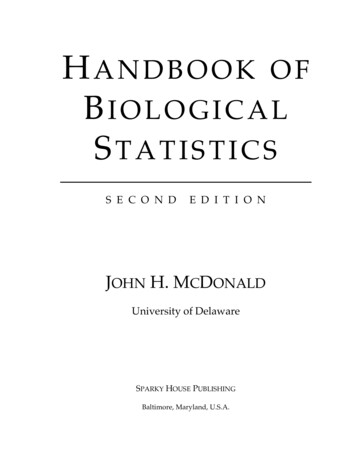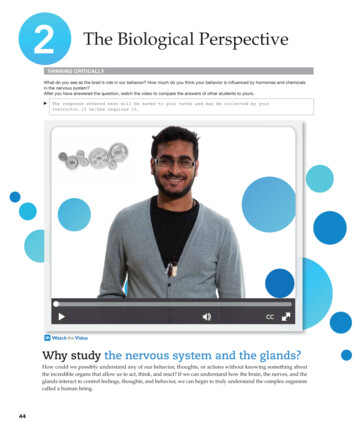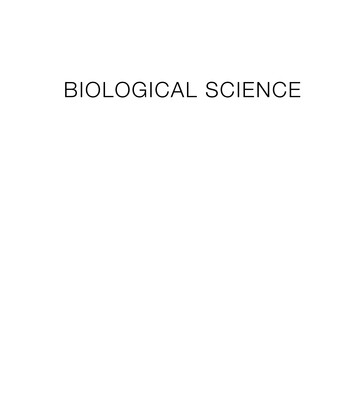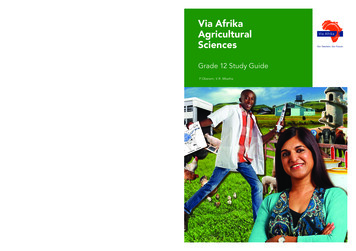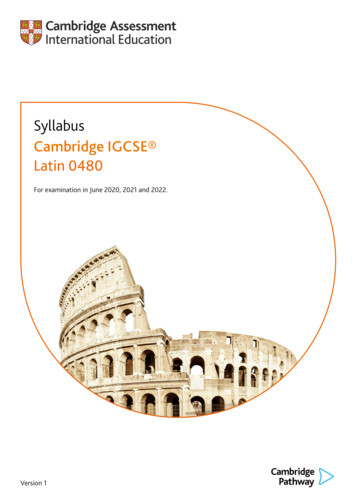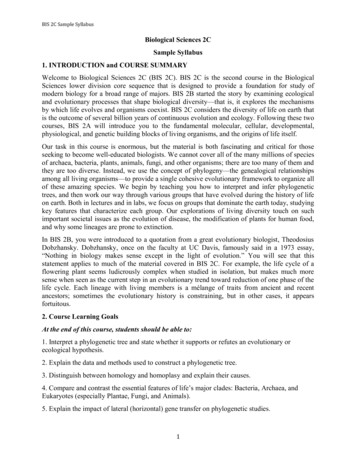
Transcription
BIS 2C Sample SyllabusBiological Sciences 2CSample Syllabus1. INTRODUCTION and COURSE SUMMARYWelcome to Biological Sciences 2C (BIS 2C). BIS 2C is the second course in the BiologicalSciences lower division core sequence that is designed to provide a foundation for study ofmodern biology for a broad range of majors. BIS 2B started the story by examining ecologicaland evolutionary processes that shape biological diversity—that is, it explores the mechanismsby which life evolves and organisms coexist. BIS 2C considers the diversity of life on earth thatis the outcome of several billion years of continuous evolution and ecology. Following these twocourses, BIS 2A will introduce you to the fundamental molecular, cellular, developmental,physiological, and genetic building blocks of living organisms, and the origins of life itself.Our task in this course is enormous, but the material is both fascinating and critical for thoseseeking to become well-educated biologists. We cannot cover all of the many millions of speciesof archaea, bacteria, plants, animals, fungi, and other organisms; there are too many of them andthey are too diverse. Instead, we use the concept of phylogeny—the genealogical relationshipsamong all living organisms—to provide a single cohesive evolutionary framework to organize allof these amazing species. We begin by teaching you how to interpret and infer phylogenetictrees, and then work our way through various groups that have evolved during the history of lifeon earth. Both in lectures and in labs, we focus on groups that dominate the earth today, studyingkey features that characterize each group. Our explorations of living diversity touch on suchimportant societal issues as the evolution of disease, the modification of plants for human food,and why some lineages are prone to extinction.In BIS 2B, you were introduced to a quotation from a great evolutionary biologist, TheodosiusDobzhansky. Dobzhansky, once on the faculty at UC Davis, famously said in a 1973 essay,“Nothing in biology makes sense except in the light of evolution.” You will see that thisstatement applies to much of the material covered in BIS 2C. For example, the life cycle of aflowering plant seems ludicrously complex when studied in isolation, but makes much moresense when seen as the current step in an evolutionary trend toward reduction of one phase of thelife cycle. Each lineage with living members is a mélange of traits from ancient and recentancestors; sometimes the evolutionary history is constraining, but in other cases, it appearsfortuitous.2. Course Learning GoalsAt the end of this course, students should be able to:1. Interpret a phylogenetic tree and state whether it supports or refutes an evolutionary orecological hypothesis.2. Explain the data and methods used to construct a phylogenetic tree.3. Distinguish between homology and homoplasy and explain their causes.4. Compare and contrast the essential features of life’s major clades: Bacteria, Archaea, andEukaryotes (especially Plantae, Fungi, and Animals).5. Explain the impact of lateral (horizontal) gene transfer on phylogenetic studies.1
BIS 2C Sample Syllabus6. Describe the role of endosymbiosis in the early history of life with special reference to theevolution of mitochondria and chloroplasts.7. Describe important innovations of microbes (bacteria, archaea, microbial eukaryotes, fungi)that have led to the ability to exploit a wide range of ecological niches (e.g., extremophiles,parasites, etc.)8. Discuss the repeated evolution of multicellularity and provide relevant examples.9. Describe the major evolutionary steps in the origin of vascular plants, seed plants, terrestrialanimals, and bilateral animal body plans; pair your description with relevant examples.10. Exemplify “tree thinking”; i.e., be able to explain the concept of phylogenetic relatedness andbe able to interpret the evolution of phenotypic features on a tree.11. Give examples of applied uses of phylogenetic analysis (e.g. conservation biology, microbialecology, co-evolution, convergent evolution, among others).General Education credits are given for literacies: SE, OL, QL, SL, VLSE. Science and Engineering: to provide students with knowledge of major scientific ideas andapplications and to communicate the scope, power, limitations and appeal of science.OL. Oral Skills: to present effective communication of ideas through oral presentation-- studentsgive 5 oral presentations in lab.QL. Quantitative Literacy: to provide students with an understanding of quantitative reasoning andskills for evaluating claims and knowledge generated through quantitative methods--students interpretdata in lab, lecture, and examinations.SL. Scientific Literacy: to provide students with an understanding of the fundamental waysscientists approach problems and generate new knowledge; an understanding of how scientificfindings relate to other disciplines and to public policy—throughout course.VL. Visual Literacy: provide students with analytical skills for still/moving images, illustrationsaccompanying text, graphs and charts, etc. used to inform and persuade people—students interpretnumerous diagrams and images; create at least one poster to master visual messaging.3. STAFF CONTACT INFORMATIONDr. Neelima Sinha from the Department of Plant BiologyEmail: nrsinha@ucdavis.edu4. COURSE DETAILSA. Grading Summary.Your grade in BIS 2C is largely based upon your grades on two lecture midterms (75 pointseach), one comprehensive final lecture exam (150 points), and performance in the laboratory(150 points total).2
BIS 2C Sample SyllabusCourse componentMidterm exam 1Midterm exam 2Final examCClickersClickersLab presentationsLab participationLab practicalTotal% of grade151530551416100Points757515025257080500* Your lab total score is determined based on the combination of lab presentations, labparticipation and the lab practical exam. For the laboratory, there are eight labs. Each lab isworth 10 points and we drop your lowest total score for one lab. Thus, the lab total is 7 x 10points 70. Please read the lab policies for details and due dates.B. Grade Determination.Grades will be determined by the percentage of the total points received in the course.A-: 90% (450 pts.)B-: 80% (400 pts.)C-: 70% (350 pts.)D: 60% (300 pts.)F: 60% (0- 300 pts.)Please note that we do not assign “ ” and “-” grades by dividing categories into thirds. Ingeneral, only the top and bottom 1.5% of each letter grade will receive “ ” and “-” grades.Grades are assigned on a percentage basis, not on the basis of a “curve.” This means that you arenot competing with other students for each grade. We encourage you to help one another learnthe material, to study together, and to work together in the laboratory portions of the course. Ifwe didn’t think our material was important, we wouldn’t cover it in lectures, labs, or discussions,so we expect you to understand at least 90% of the material to get a high grade.5. COURSE COMPONENTS and GRADINGA. Lecture Exams.Lecture exams consist of multiple choice and fill-in or short answer questions; they might alsorequire you to draw a phylogenetic tree or do a calculation. They are based upon lecture anddiscussion materials, study questions, and reading assigned for the lecture and discussionsections that supports material covered in class.B. Laboratory.The laboratories for BIS 2C are designed to complement topics presented in lecture.Details of the lab are provided in the lab policies and the manual (see required texts,below). Labs are worth 10 points each: 5 points for the pre-lab and 5 points for the post-lab. 3
BIS 2C Sample Syllabus Pre-Labs must be completed and turned in by 9AM on Monday of the lab week.Post-labs are due by the start of your next lab.If you do not turn in the pre-lab, you will be allowed to attend lab, but you will forfeitpoints for both the pre and post-lab for that week. You will still be eligible for full crediton presentations that week.You are encouraged to discuss the pre-lab in a study group, but written answers should beentirely your own.Be mindful of external resources when doing pre and post-labs; answers must be entirelyyour own.Pre-labs will be submitted electronically via the class Canvas site. Some post-labsrequire pages from your lab to be submitted in lab as a hard copy. Only original pagesfrom a new, unused lab manual will be accepted.Because of the nature of the labs and because lab sections are full, if you miss your labfor any reason you may not attend another lab that week. There are no make-ups,however we will drop your lowest score so if you miss a lab that will be the one droppedscore.For the laboratory, you must buy the Laboratory Manual for Biological Sciences 2C—aused copy is not acceptable because there are tear out exercises in the lab manual.C. Laboratory Presentations As part of BIS 2C, you receive several general education credits for Scientific Literacy.This is accomplished through student presentations in labs. Your TA will guide you inthe improvement of your presentations skills, and we expect you to take this part of thecourse seriously.Your presentations will be evaluated using a standard rubric, which is designed to giveyou direct feedback on your performance. Your presentations will be graded using thisrubric for a total of 25 points, with 5 points each from labs 4 and 5 and 15 points from lab8.D. Laboratory Practical Exam.The lab practical is an 80-point examination testing whether students have grasped thegoals and objectives of each lab. It is called a "practical" examination because it testshands-on skills such as recognizing organisms, identifying important body parts, andusing techniques such as microscopy. To prepare for the practical: make sure you meetthe goals and objectives listed for each lab, review group exercises, and examinespecimens in lab carefully. A practice lab practical will be provided two weeks prior to the exam. E. Launchpad “Learning Curve’.As part of the purchase of a new copy of the Sadava et al. 11th edition, you receive oneyear of access to their Launchpad website. We have assigned chapter readings thatsupplement the lecture topics and there are associated questions on Launchpad, but theyare not eligible for extra credit. If you did not purchase a new textbook, you may purchase access to Launchpad 11e/9812730 4
BIS 2C Sample SyllabusLook for our course using the instructor names and quarter on the Launchpad website andbe sure to register using your student ID. Since this is an external service, we have no control over access. Please contact customerservice if you experience any problems at (800) 936-6899. F. Textbook and Lab Book.Textbook: The main text for the class is Life: the science of biology 11th edition, bySadava, Hillis, Heller, and Hacker (ISBN 9781319010164). For the laboratory, you will get a copy of Intro. to Biology Laboratory Manual forBiological Sciences 2C. G. Readings. The course schedule includes a list of readings associated with each lecture.A list of textbook readings will be posted that summarize lecture content.The textbook is an excellent resource, but exam questions and other graded activities willbe largely focused on lecture content.H. Academic . Be sure you understand what constitutes misconduct—wesend all suspected cases to Student Judicial Affairs. Common SJA violations in BIS2C include: Plagiarism on pre and post-lab assignments. If you copy answers from the internet or aclassmate, you will be referred to SJA. This will result in a grade of 0 on assignment andthat lab not being eligible to be dropped as the lowest lab grade.Wandering eyes and/or cheating on exams. If we suspect misconduct during exams, yourbehavior may be filmed and you will be referred to SJA. This will result in a gradepenalty of 20% - 100% of the exam points, assigned at our discretion.6. TEN HINTS1. Take CAREFUL notes. This course relies more on lectures and in-class discussions, andmuch less on the textbook. If a topic was interesting or generated discussion in lecture, it islikely to be on an exam.2. Go over your notes for clarity soon after the lecture. You may want to re-listen to thelectures. Ask yourself what point was being made in each part of the lecture.3. Trust your TA. They are an invaluable resource in the course, and are there to help yousucceed.4. Ask for help! Visit the CLC (Room 3089 SLB) as soon as you realize that you have aproblem with something.5. Work through all of the online activities, study questions, study guides, and practice exams.6. Spend all the laboratory time focused on the lab itself, and the goals of the lab. Before youleave, make sure you have achieved all of the goals of the lab, which are listed at thebeginning of each lab in your lab manual.7. Find out what you had wrong on each exam, and why it was wrong. Learn the right answer(the course is cumulative).5
BIS 2C Sample Syllabus8. Concepts are more important than memorization. Try to find the ‘story’ provided for eachexample in lecture; the main idea is often listed at the top of each lecture slide.9. Keep up with the course. Lectures cover a lot of material, they build on each other (that’s thepoint!), and once you are behind it will be difficult to recover.10. Please put BIS 2C in the header of any email you send to course staff or faculty so we cantell it is not spam.6
BIS 2C Sample Syllabus 4 Pre-Labs must be completed and turned in by 9AM on Monday of the lab week. Post-labs are due by the start of your next lab. If you do not turn in the pre-lab, you will be allowed to attend lab, but you will forfeit points for both the pre and post-lab for that week. You will still be eligible for full credit


